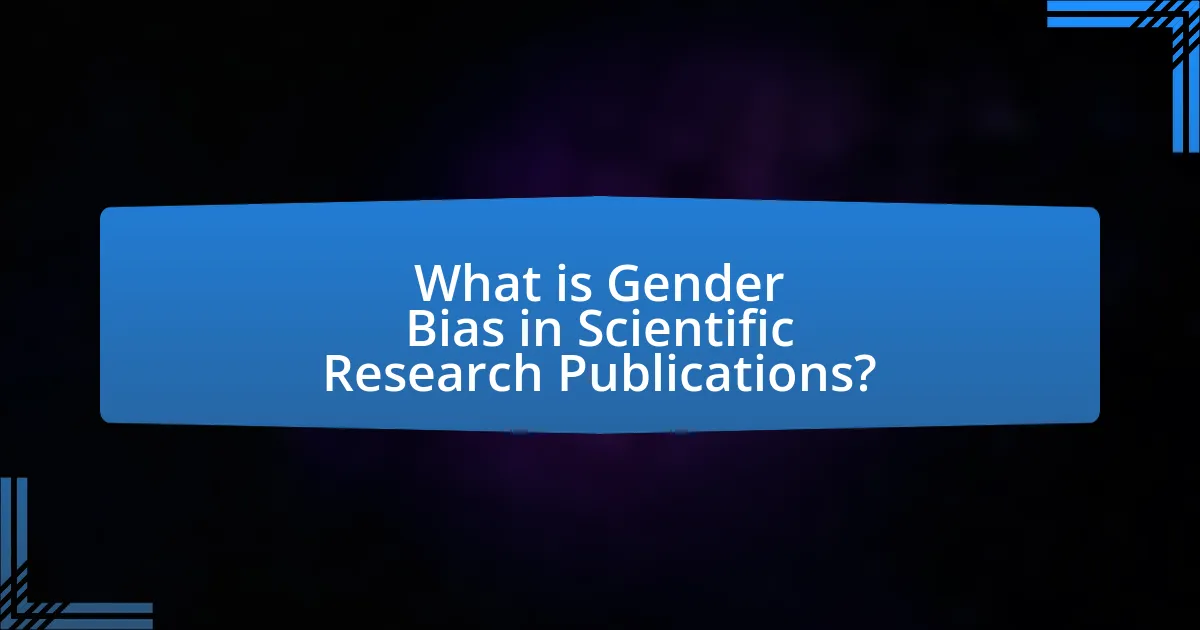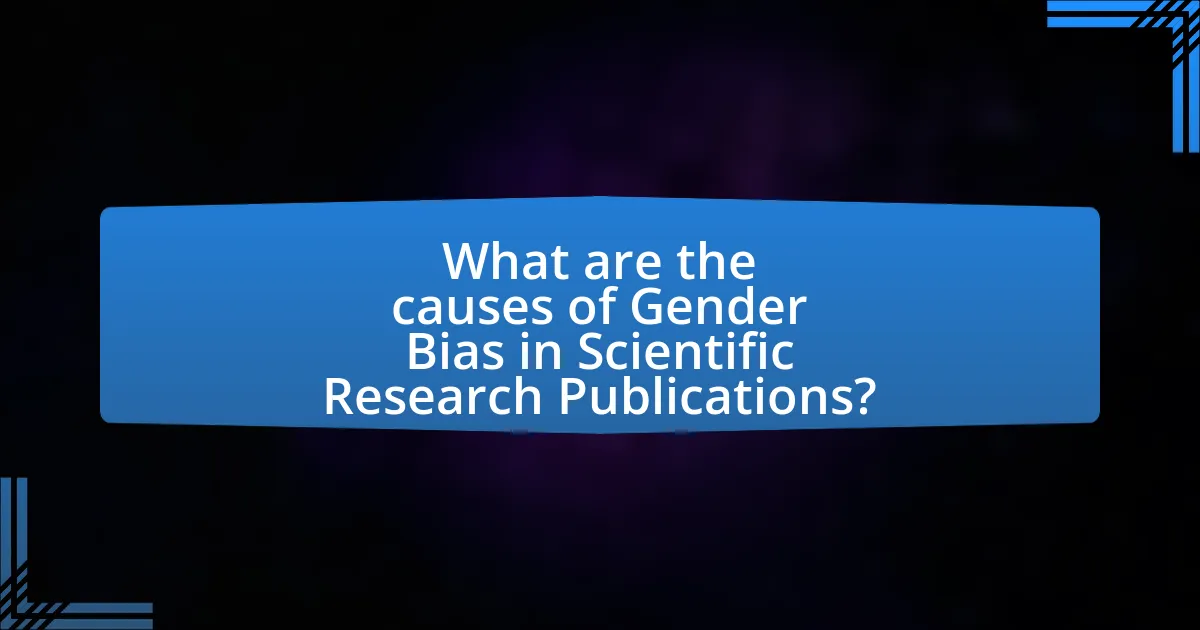Gender bias in scientific research publications refers to the systematic discrimination against one gender, often resulting in unequal representation and recognition in research outputs. This article examines how gender bias manifests through disparities in authorship, citation practices, and editorial decisions, highlighting the underrepresentation of women in high-impact journals and the differential evaluation of research quality based on gender. It discusses the implications of gender bias on scientific knowledge, innovation, and funding opportunities, as well as the institutional and societal factors that contribute to these disparities. Strategies for addressing gender bias, including promoting gender-balanced authorship, implementing transparent peer review processes, and fostering a culture of inclusivity in research, are also explored.

What is Gender Bias in Scientific Research Publications?
Gender bias in scientific research publications refers to the systematic favoritism or discrimination against one gender, often resulting in unequal representation, recognition, and opportunities in research outputs. This bias manifests in various ways, including the underrepresentation of women as authors, the tendency to cite male authors more frequently, and the differential evaluation of research quality based on the gender of the authors. Studies have shown that women are less likely to be published in high-impact journals compared to their male counterparts, which highlights the pervasive nature of this bias in the academic landscape. For instance, a study published in the journal “Nature” found that women authors were cited less frequently than men, indicating a significant disparity in recognition and influence within the scientific community.
How does gender bias manifest in scientific research publications?
Gender bias in scientific research publications manifests through disparities in authorship, citation practices, and editorial decisions. Research indicates that women are underrepresented as authors in high-impact journals, with studies showing that only 30% of published research articles in top-tier journals have female first authors. Additionally, male-authored papers tend to receive more citations than those authored by women, perpetuating a cycle of recognition and funding that favors male researchers. Furthermore, editorial boards of many prestigious journals often lack gender diversity, which can influence the acceptance rates of submissions from female authors. These patterns highlight systemic biases that disadvantage women in the scientific community.
What are the common indicators of gender bias in research authorship?
Common indicators of gender bias in research authorship include disparities in authorship positions, citation rates, and publication rates between male and female researchers. Studies have shown that women are often underrepresented in first and senior author positions, which are typically associated with greater recognition and influence. For instance, a systematic review published in the journal “Nature” found that women constituted only 30% of first authors in biomedical research articles. Additionally, research indicates that papers authored by women receive fewer citations compared to those authored by men, further highlighting the bias in recognition and impact. Furthermore, the overall publication rates for women tend to be lower, reflecting systemic barriers in access to funding and research opportunities.
How does gender bias affect the peer review process?
Gender bias negatively impacts the peer review process by leading to unequal evaluations of research based on the gender of the authors. Studies have shown that female-authored papers are often subjected to more rigorous scrutiny and receive lower ratings compared to male-authored papers, even when the quality of the research is comparable. For instance, a study published in the journal “Nature” found that female researchers faced a higher likelihood of receiving negative feedback and lower acceptance rates than their male counterparts, indicating systemic bias in the evaluation process. This bias can discourage women from submitting their work and perpetuate gender disparities in scientific publications.
Why is addressing gender bias in scientific research important?
Addressing gender bias in scientific research is important because it ensures equitable representation and validity in scientific findings. Gender bias can lead to skewed research outcomes, as studies may overlook or misrepresent the experiences and contributions of women and non-binary individuals. For instance, a 2019 study published in the journal “Nature” found that male authors dominate in high-impact journals, which can perpetuate stereotypes and limit the diversity of scientific inquiry. By addressing this bias, the scientific community can enhance the quality and applicability of research, ultimately leading to more comprehensive and reliable knowledge.
What impact does gender bias have on scientific knowledge and innovation?
Gender bias significantly undermines scientific knowledge and innovation by perpetuating inequalities in research funding, publication opportunities, and recognition. Studies indicate that women are underrepresented in leadership roles and often face barriers in securing grants, which limits diverse perspectives in research. For instance, a 2019 analysis published in the journal “Nature” found that female authors are less likely to be cited than their male counterparts, leading to a skewed understanding of scientific contributions. This bias not only affects the visibility of women’s work but also hinders the advancement of innovative ideas that could arise from a more inclusive scientific community.
How does gender bias influence funding opportunities for researchers?
Gender bias significantly influences funding opportunities for researchers by creating disparities in the allocation of grants and financial support based on gender. Studies indicate that female researchers often receive less funding than their male counterparts, even when controlling for factors such as experience and the quality of proposals. For instance, a 2019 analysis published in the journal “Nature” found that women-led research proposals were 10% less likely to receive funding compared to those led by men, despite similar merit levels. This bias can stem from stereotypes about women’s capabilities in research, leading to a systemic disadvantage that affects career advancement and the overall diversity of scientific inquiry.

What are the causes of Gender Bias in Scientific Research Publications?
Gender bias in scientific research publications is primarily caused by systemic inequalities in the academic and research environments. These inequalities manifest through factors such as the underrepresentation of women in leadership roles, which influences funding decisions and publication opportunities. Research indicates that women are less likely to be invited to contribute to high-profile journals, leading to fewer publications and citations compared to their male counterparts. Additionally, implicit biases in peer review processes can disadvantage female authors, as studies show that reviewers may unconsciously favor male-authored papers. Furthermore, societal stereotypes about gender roles can affect the perception of women’s contributions in science, perpetuating a cycle of bias.
How do societal norms contribute to gender bias in research?
Societal norms contribute to gender bias in research by perpetuating stereotypes that influence the selection of research topics, funding opportunities, and authorship recognition. These norms often prioritize male perspectives and experiences, leading to a lack of representation of women’s contributions in various fields. For instance, a study published in the journal “Nature” found that women are underrepresented in research leadership roles, which affects the types of questions that are prioritized and the visibility of women’s research. Additionally, biases in peer review processes can disadvantage female researchers, as studies have shown that manuscripts authored by women are often rated lower than those by men, regardless of the quality of the work. This systemic bias reinforces the notion that male contributions are more valuable, further entrenching gender disparities in scientific research.
What role do stereotypes play in the perception of researchers?
Stereotypes significantly influence the perception of researchers by shaping assumptions about their capabilities and credibility based on gender, ethnicity, or other characteristics. For instance, studies have shown that female researchers often face biases that question their authority and expertise compared to their male counterparts, leading to underrepresentation in publications and funding opportunities. Research published in the journal “Nature” by Budden et al. (2008) found that women are less likely to be cited than men, reflecting a stereotype that undermines their contributions in scientific fields. This bias not only affects individual researchers but also perpetuates systemic inequalities within the scientific community.
How does the academic environment perpetuate gender bias?
The academic environment perpetuates gender bias through systemic inequalities in hiring, promotion, and funding practices. Research indicates that women are often underrepresented in leadership positions within academia, which affects decision-making processes and resource allocation. For instance, a study published in the journal “Nature” found that women receive less funding than their male counterparts, with only 30% of women applying for grants compared to 50% of men. Additionally, implicit biases in peer review processes can lead to the undervaluation of women’s research contributions, further entrenching gender disparities. These factors collectively create an environment where gender bias is normalized and perpetuated, impacting women’s career advancement and representation in scientific research.
What institutional factors contribute to gender bias in research?
Institutional factors contributing to gender bias in research include unequal funding opportunities, lack of representation in leadership positions, and biased peer review processes. Research shows that women-led projects receive significantly less funding compared to those led by men, which limits their ability to conduct and publish research. Additionally, women are underrepresented in senior academic roles, which affects decision-making and mentorship opportunities for junior female researchers. Furthermore, studies indicate that peer review processes often favor male authors, leading to disparities in publication rates. These factors collectively perpetuate gender bias within the research landscape.
How do hiring and promotion practices affect gender representation in research?
Hiring and promotion practices significantly influence gender representation in research by determining which individuals gain access to academic positions and advancement opportunities. Research indicates that biased hiring processes, such as reliance on subjective evaluations and networking, often disadvantage women, leading to underrepresentation in research roles. For instance, a study published in the journal “Nature” found that women are less likely to be hired for tenure-track positions compared to their male counterparts, even when they have similar qualifications. Additionally, promotion practices that favor established networks and mentorship can perpetuate gender disparities, as women often have less access to influential mentors. This systemic bias in hiring and promotion not only affects individual careers but also contributes to a lack of diverse perspectives in research, ultimately impacting the quality and breadth of scientific inquiry.
What policies can exacerbate or mitigate gender bias in research settings?
Policies that can exacerbate gender bias in research settings include those that prioritize metrics like publication quantity over quality, which can disadvantage women who may face additional barriers to publishing. For instance, the emphasis on citation counts can perpetuate existing biases, as studies show that women’s work is often cited less frequently than men’s, regardless of quality. Conversely, policies that promote gender equity, such as mandatory diversity training for review committees and equitable funding opportunities, can mitigate gender bias. Research indicates that institutions implementing gender equity policies see improved representation and outcomes for women in research roles, as evidenced by the increase in female authorship in journals that adopt such measures.

What strategies can be implemented to address Gender Bias in Scientific Research Publications?
To address gender bias in scientific research publications, implementing strategies such as promoting gender-balanced authorship, enforcing transparent peer review processes, and providing bias training for reviewers is essential. Research indicates that gender-balanced authorship leads to more equitable representation and can enhance the quality of research outputs. For instance, a study published in the journal “Nature” found that papers with female authors are cited more frequently when they are co-authored with male colleagues, highlighting the importance of collaboration in overcoming bias. Additionally, transparent peer review processes can reduce bias by allowing for greater scrutiny of reviewer comments and decisions, as shown in a report by the Royal Society. Lastly, bias training for reviewers can raise awareness of unconscious biases, leading to fairer evaluations of submissions, as evidenced by initiatives in various academic institutions that have successfully reduced bias in publication outcomes.
How can awareness and training reduce gender bias in research?
Awareness and training can significantly reduce gender bias in research by equipping researchers with the knowledge and skills to recognize and address their own biases. Training programs that focus on implicit bias, gender stereotypes, and equitable research practices help researchers understand how these biases can influence study design, data interpretation, and publication outcomes. For instance, a study published in the journal “Nature” found that training interventions led to a measurable increase in the representation of women in research teams and publications, demonstrating the effectiveness of such initiatives. By fostering an environment of awareness, researchers are more likely to implement inclusive practices that promote gender equity in scientific research.
What types of training programs are effective in addressing gender bias?
Effective training programs for addressing gender bias include implicit bias training, diversity and inclusion workshops, and mentorship programs. Implicit bias training helps participants recognize and mitigate unconscious biases that affect decision-making and evaluations. Research indicates that such training can lead to increased awareness and changes in behavior, as demonstrated in studies like “The Effect of Implicit Bias Training on Gender Bias in Academic Hiring” published in the Journal of Higher Education. Diversity and inclusion workshops foster an understanding of systemic inequalities and promote inclusive practices, which have been shown to improve workplace culture and reduce bias. Mentorship programs, particularly those that pair underrepresented groups with experienced mentors, can enhance career development and support, thereby addressing gender disparities in professional advancement.
How can institutions promote a culture of inclusivity in research?
Institutions can promote a culture of inclusivity in research by implementing policies that actively support diverse representation among researchers and decision-makers. For instance, establishing mentorship programs aimed at underrepresented groups can enhance participation and visibility in research fields. Additionally, institutions can adopt transparent hiring practices that prioritize diversity, as evidenced by studies showing that diverse teams produce more innovative research outcomes. Furthermore, providing training on unconscious bias for all staff involved in research can help create an environment that values inclusivity, leading to more equitable research practices.
What role do journals and publishers play in combating gender bias?
Journals and publishers play a crucial role in combating gender bias by implementing policies that promote equitable representation and fair evaluation processes. They can establish guidelines that ensure diverse authorship and editorial boards, which helps to mitigate biases in the peer review process. For instance, initiatives like the Gender Equality in Publishing (GEP) initiative encourage journals to track gender representation in submissions and publications, fostering transparency and accountability. Additionally, publishers can provide training for editors and reviewers on implicit bias, which has been shown to influence decision-making in academic publishing. By actively addressing these issues, journals and publishers contribute to a more inclusive and equitable research environment.
How can editorial policies be revised to ensure fairness in publication processes?
Editorial policies can be revised to ensure fairness in publication processes by implementing transparent guidelines that promote diversity and inclusivity. These guidelines should include mandatory training for editors on unconscious bias, ensuring that editorial boards reflect diverse demographics, and establishing clear criteria for manuscript evaluation that prioritize merit over affiliation or gender. Research indicates that diverse editorial boards can lead to more equitable publication outcomes, as seen in a study published in the journal “Nature” which found that gender-diverse teams are more likely to consider a wider range of perspectives, ultimately enhancing the quality of published research.
What initiatives can journals adopt to support gender equity in research?
Journals can adopt initiatives such as implementing blind peer review processes to support gender equity in research. This approach minimizes biases related to the authors’ identities, allowing for a more equitable evaluation of research quality. Studies have shown that blind review can reduce gender bias in publication decisions, as evidenced by research published in the journal “Nature” which highlighted that gender-neutral evaluations lead to fairer outcomes for female authors. Additionally, journals can establish mentorship programs for underrepresented genders in academia, providing guidance and support that can enhance their chances of publication success.
What best practices can researchers adopt to minimize gender bias in their work?
Researchers can minimize gender bias in their work by implementing blind review processes, ensuring diverse representation in research teams, and using gender-neutral language in publications. Blind review processes help eliminate bias by concealing the identities of authors and reviewers, which has been shown to improve the fairness of evaluations (Budden et al., 2008). Diverse representation in research teams enhances the breadth of perspectives and reduces the likelihood of unconscious bias influencing research outcomes, as studies indicate that diverse teams produce more innovative solutions (Page, 2007). Additionally, using gender-neutral language prevents reinforcing stereotypes and promotes inclusivity, as evidenced by guidelines from organizations like the American Psychological Association, which advocate for language that does not favor one gender over another.
How can researchers ensure equitable authorship and acknowledgment in publications?
Researchers can ensure equitable authorship and acknowledgment in publications by establishing clear authorship criteria and engaging in open discussions about contributions at the project’s outset. Implementing guidelines, such as those from the International Committee of Medical Journal Editors, which recommend that all authors meet specific criteria for authorship, helps clarify roles and responsibilities. Additionally, utilizing tools like contribution statements can provide transparency regarding each author’s specific contributions, thereby reducing bias and ensuring that all contributions are recognized fairly. Studies have shown that transparent authorship practices can lead to more equitable representation in scientific literature, addressing gender bias effectively.
What steps can be taken to promote diverse collaboration in research projects?
To promote diverse collaboration in research projects, institutions should implement targeted recruitment strategies that prioritize underrepresented groups in academia. This can be achieved by establishing partnerships with minority-serving institutions and creating mentorship programs that support diverse researchers. Research indicates that diverse teams enhance creativity and problem-solving, leading to more innovative outcomes (Page, S.E. 2007, “The Difference: How the Power of Diversity Creates Better Groups, Firms, Schools, and Societies”). Additionally, fostering an inclusive culture through training on unconscious bias can help create an environment where diverse voices are valued and heard.


